Introduction
Pilates is a highly effective exercise method that focuses on building core strength, improving flexibility, and enhancing overall body awareness. Whether you’re looking to tone your muscles, increase your range of motion, or simply find a new way to stay active, Pilates offers a versatile and rewarding practice. If you’re new to Pilates, getting started might seem daunting, but with the right tips and guidance, you can embark on a successful and enjoyable Pilates journey. This article will provide you with essential tips for beginners to help you start your Pilates practice with confidence.
- Understand the Basics of Pilates: Before diving into your first Pilates session, it’s important to understand the fundamental principles of Pilates. Pilates emphasizes controlled movements, proper alignment, breath control, and a strong mind-body connection. Familiarize yourself with these core principles to get the most out of your practice and ensure that you perform each exercise safely and effectively.
- Choose the Right Pilates Class: As a beginner, it’s beneficial to start with a beginner-friendly Pilates class or a private session with a certified Pilates instructor. Look for classes specifically designed for beginners, as these will provide a slower pace and detailed instructions to help you learn the basics. If you prefer the comfort of your own home, there are many online platforms offering beginner Pilates classes that you can follow along with.
- Invest in Basic Pilates Equipment: While Pilates can be performed with minimal equipment, having a few basic items can enhance your practice. A high-quality Pilates mat provides cushioning and support for floor exercises. Additionally, small props like resistance bands, Pilates rings, and foam rollers can add variety and challenge to your workouts. As you progress, you may want to explore Pilates equipment like the Reformer, but it’s not necessary for beginners.
- Focus on Your Breath: Breathing is a crucial aspect of Pilates that helps you connect with your movements and activate your core muscles. Practice deep, diaphragmatic breathing, inhaling through your nose and exhaling through your mouth. Coordinate your breath with your movements: inhale to prepare and exhale as you execute the movement. This mindful breathing enhances your concentration, promotes relaxation, and supports proper muscle engagement.
- Start Slow and Build Gradually: When starting Pilates, it’s important to take it slow and build your strength and flexibility gradually. Begin with basic exercises that focus on core stabilization, such as the pelvic curl, single leg stretch, and spine twist. As you become more comfortable with these foundational movements, you can gradually incorporate more challenging exercises and sequences into your routine.
- Pay Attention to Alignment and Form: Proper alignment and form are key to getting the most out of your Pilates practice and preventing injuries. Focus on maintaining a neutral spine, engaging your core muscles, and aligning your head, shoulders, and hips. Avoid straining or overexerting yourself, and listen to your body. If you’re unsure about your form, consider working with a certified Pilates instructor who can provide personalized guidance and corrections.
- Incorporate Consistency and Patience: Consistency is essential for progress in Pilates. Aim to practice Pilates at least 2-3 times per week to build strength, flexibility, and endurance. Be patient with yourself, as it may take time to see and feel the benefits of your practice. Remember that Pilates is a journey, and every session is an opportunity to improve and connect with your body.
- Listen to Your Body: Pilates is a gentle and adaptable exercise method, but it’s important to listen to your body and respect its limits. If you experience pain or discomfort during any exercise, stop immediately and consult with an instructor or healthcare professional. Modify exercises as needed and give yourself permission to rest and recover.
Conclusion
Starting a Pilates practice as a beginner can be both exciting and challenging. By understanding the basics, choosing the right class, focusing on your breath, and paying attention to alignment and form, you can build a strong foundation for your Pilates journey. Remember to start slow, be consistent, and listen to your body as you progress. With patience and dedication, you’ll soon experience the many physical and mental benefits that Pilates has to offer. Embrace the journey and enjoy the process of becoming stronger, more flexible, and more connected with your body through Pilates.
Discover more from Pilates All Ages
Subscribe to get the latest posts sent to your email.
